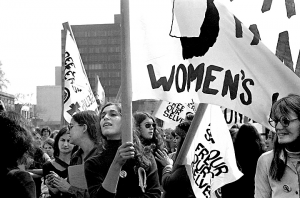Equal pay and equal opportunity for women. Today these are basic rights, not radical concepts. But less than 50 years ago, The New York Times still had separate want ads for men and women.
“All the good jobs—the premier jobs—were for the males,” says Jacqui Ceballos in She's Beautiful When She's Angry, an inspiring documentary about the women’s liberation movement.
Ceballos is just one of the inspiring heroines in this film festival favorite that captures the energy and brilliance of second-wave feminists between 1966 and 1971: the daring women on the front lines of the movement who fought the status quo with courage, intelligence and often humor.
Witness the so-called “bra-burning” at the 1968 Miss America Pageant, at which no bras are burned, contrary to myth. Instead we see gleeful women whipping bras, girdles and other “instruments of female torture” over their heads before tossing them into a “freedom trash can.” There to protest the sexism of the pageant and society, they later unfurl a “Women’s Liberation” banner on nationwide television, introducing the concept to many for the first time.
“It was a blast. What can I say?” says the now 90-year-old Ceballos, who worked for the more mainstream National Organization for Women but was “always with the radicals,” as she puts it.
With moving footage, candid interviews and great music, the film documents the activism of these women who fought for equal opportunity and pay, child care, reproductive and sexual freedom, and respect—in short, they demanded the freedom to determine the course of their lives.
Want to explore the movement further? Check out Daring to Be Bad: Radical Feminism in America, 1967 - 1975, which features many activists from the film including Rita Mae Brown, Susan Brownmiller and Ellen Willis, the latter of whom wrote the title's incisive foreword. Today, it's striking how mainstream some of the “radical” feminists’ ideas seem, largely because of their efforts. (Who knew that “every mother is a working mother” was coined by radical feminists?)
Finally, a fascinating book and historical document is Sisterhood Is Powerful: An Anthology of Writing from the Women's Liberation Movement. Published in the thick of the movement in 1970, it features essays by well-known feminists like Kate Millett and Eleanor Holmes Norton but also the work of everyday women on the sexism they experience; manifestos by influential feminist groups like Redstockings; sexist comments made by professors at a Chicago university recounted by university women; a collective diary by high school girls in New York and more. The writing is often intensely personal: You feel their frustration and anger, but, more importantly, their determination and their commitment to collective action.
As former Chicago NOW president Mary Jane Collins says in She’s Beautiful When She’s Angry, “You can’t convince me that you can’t change the world. Because I saw it happen.”




Add a comment to: The Heroines of the Women’s Liberation Movement